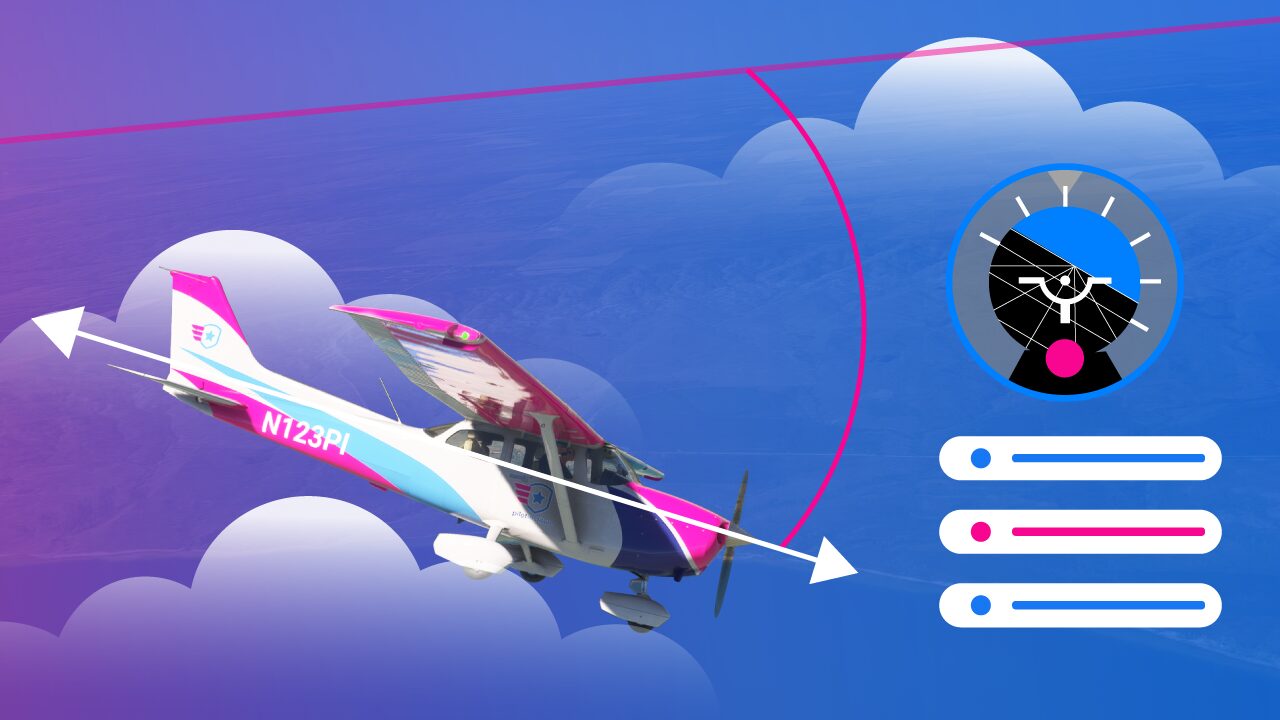One of the leading causes of fatal general aviation accidents is the loss of aircraft control.
Imagine you’re stuck in a spiral dive, hurtling toward the ground. Completely disoriented and unsure of which way is up.
How did you find yourself in this dire situation?
Most likely because of an unusual attitude. If you had the knowledge to recover from such a state, the outcome could have been very different.
In this article, we will cover everything you need to know about unusual attitudes. Most importantly, how to regain control of the aircraft when you’re disoriented.
Understanding this could be the difference between life and death.
What are Unusual Attitudes?
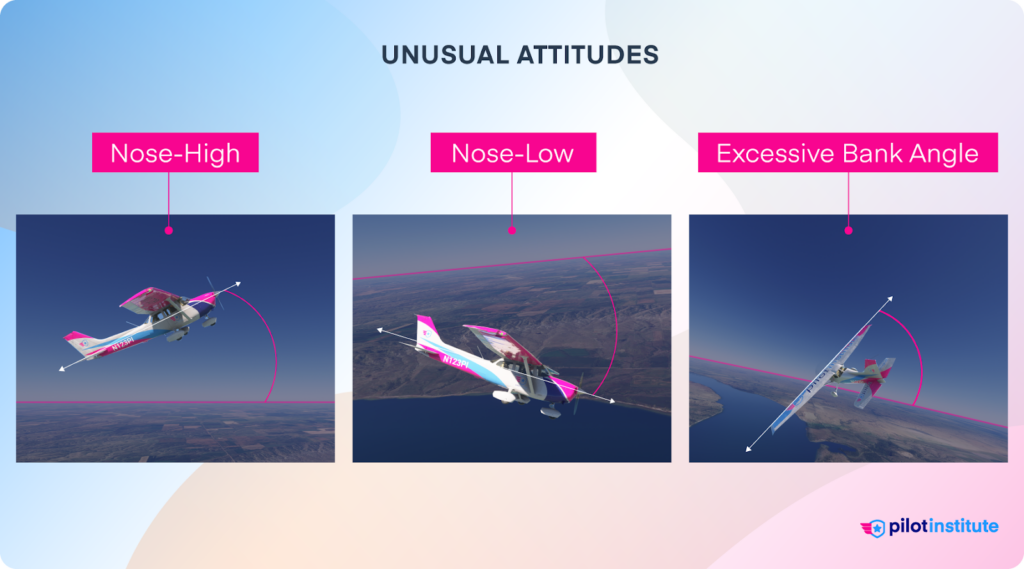
An unusual attitude is an extreme aircraft pitch/roll attitude that is not necessary for normal flight. It is unexpected and unintended.
The main types of unusual attitudes are nose-high and nose-low. The most dangerous of the nose-low attitudes is the spiral dive, as it can be hard to identify.
Why are unusual attitudes so dangerous?
The main reason is disorientation. Being disoriented causes the pilot to make incorrect control corrections. This could escalate the situation into a self-inducing dive or stall. Being unable to recognize and recover from unusual attitudes can be fatal.
Causes of Unusual Attitudes
We know what an unusual attitude is, but how do we get into one in the first place?
Three primary factors can lead us to an unusual attitude. Understanding each of these causes is vital. It allows us to recognize the warning signs and take proactive steps to avoid them.
Human Factors
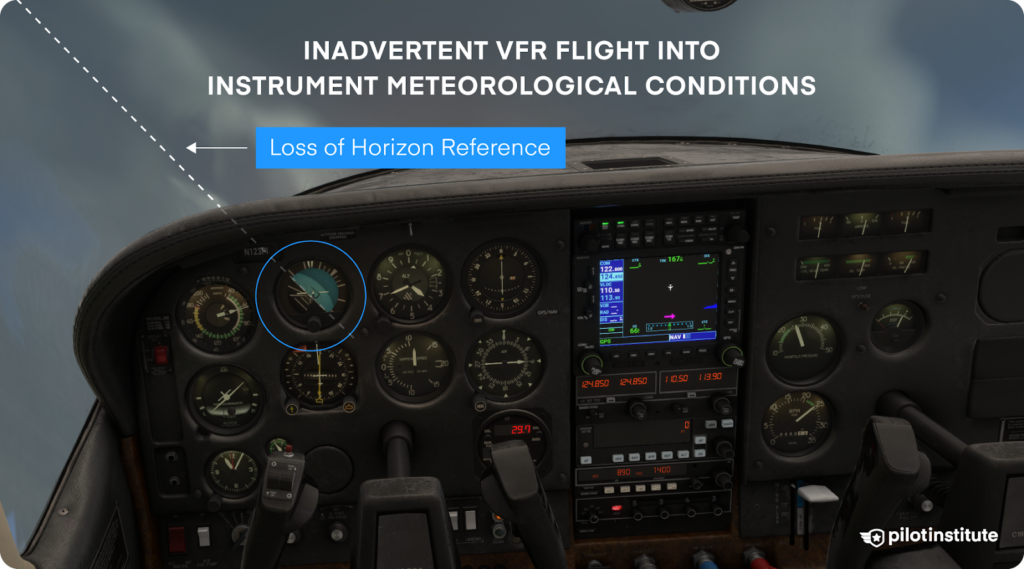
Inadvertent Flight into the Cloud
- You lose reference to the natural horizon when flying into the cloud.
- The loss of visual reference can lead to spatial disorientation and vertigo.
- This disorientation can cause abrupt and incorrect control inputs, causing an unusual attitude.
- If in this situation, make sure to transition your eyes to inside the flight deck. Ensure you fly the aircraft in accordance with your instruments.
High Workload
- During a period of high workload, a pilot can become overloaded. Their cognitive ability to focus on multiple tasks is severely reduced.
- This can cause a loss of concentration on the main task of flying the aircraft.
- Failing to monitor your instruments can lead to an unusual attitude.
- Make sure you have a framework to deal with periods of high workload. You must prioritize flying the aircraft.
Startle Response
- Startle is an automated human response that happens during a sudden event.
- Startle affects a pilot’s mental processing.
- This leads to abrupt and incorrect control inputs. In turn, this can lead to a self-induced unusual attitude.
- Pilots can protect themselves from startle through scenario-based training. Having a framework to deal with the initial response will also help.
Environmental Factors
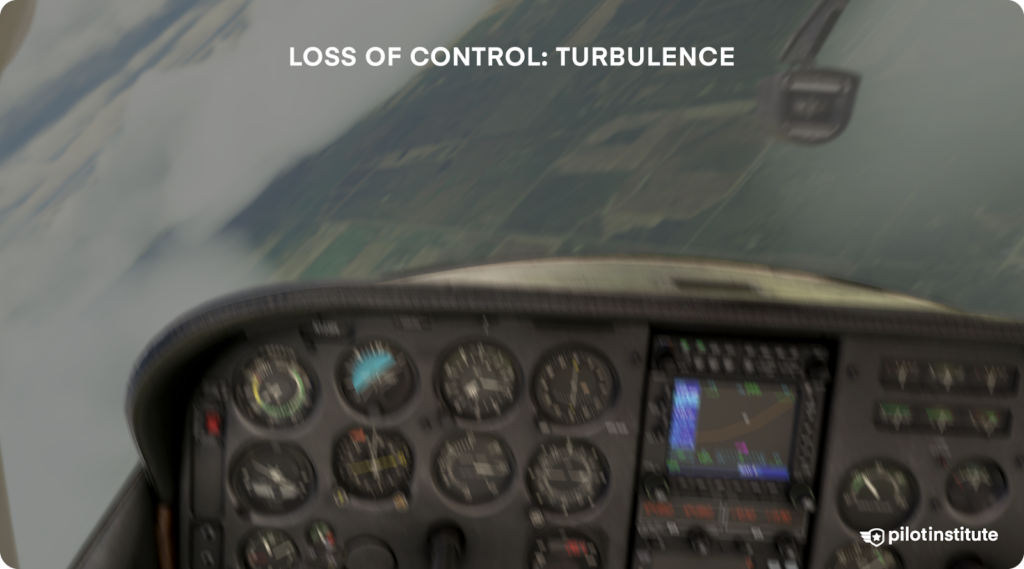
Turbulence
- Severe turbulence can cause disruption to an aircraft’s flight.
- In some cases, the aircraft may lose control due to the severity of the turbulence.
- An aircraft can enter an unusual attitude if not acted upon in a quick manner.
Icing
- Icing on the aerofoil disrupts the smooth airflow over the wings that produce lift.
- This decrease in lift has the potential to cause the aircraft to stall. This may lead to an unusual attitude.
- Conduct a thorough weather briefing prior to the flight. This will ensure knowledge of any environmental conditions.
Mechanical Factors
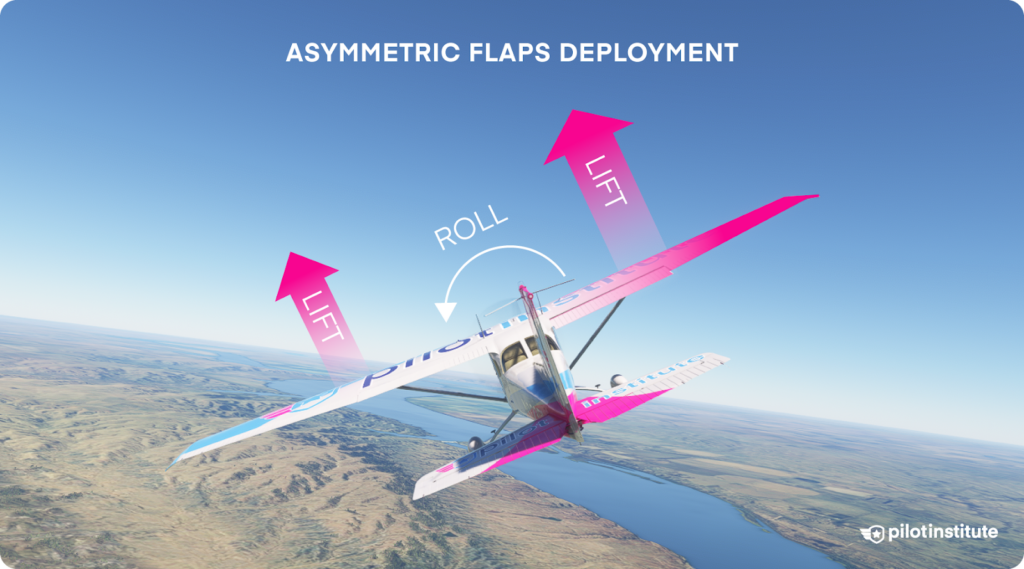
Failures
- Mechanical components can fail due to system malfunctions or incorrect usage.
- Failures of major mechanical systems can cause serious handling issues. Some examples include flap asymmetry and control surface jamming.
- If you don’t control the failures, there is the potential to end up in an unusual attitude.
- Make sure to prioritize flying the aircraft. Refer to the manufacturer’s QRH to deal with the failure.
Recognizing and Recovering from Unusual Attitudes
Now, to the important part. Knowing how to recognize and recover from an unusual attitude. Awareness of unusual attitudes can be life-saving.
Nose-High Attitude
Recognition
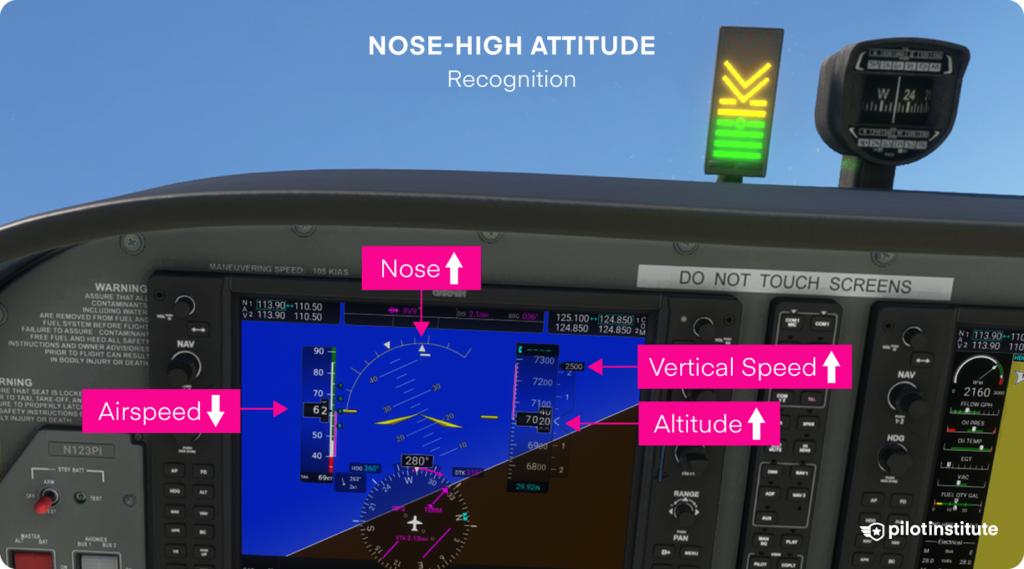
During a nose-high unusual attitude, you will have the following:
- Low or decreasing airspeed – read from your airspeed indicator.
- Increasing altitude – read from your altimeter.
- An increasing rate of climb – read from your vertical speed indicator.
- Decrease of engine RPM – read from your engine RPM gauge.
- A high-nose attitude – seen on your attitude indicator.
Recovery
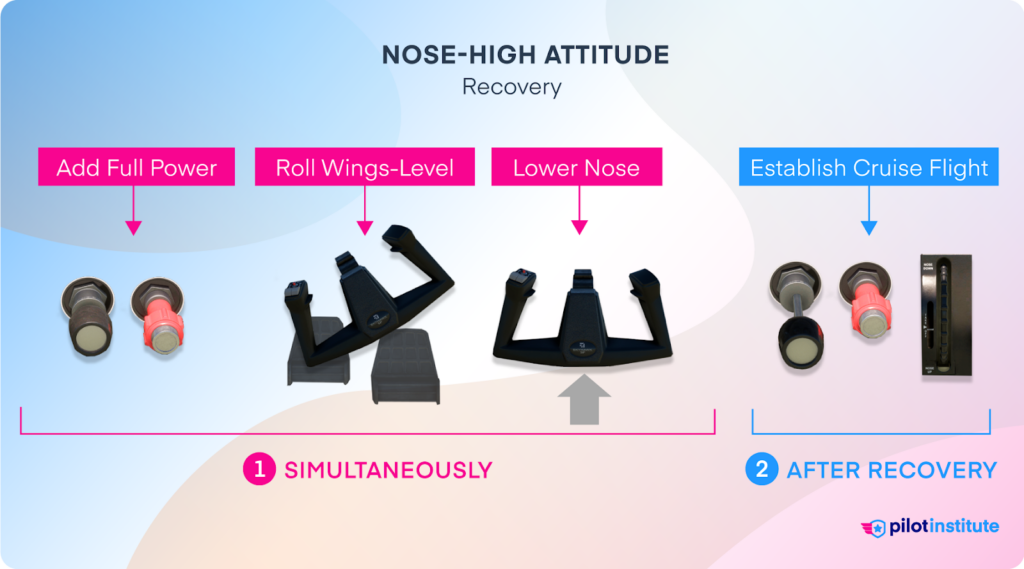
As soon as you notice you are entering an unusual nose-high attitude, apply full power. Simultaneously level the wings. Push forward on the control column so your airspeed increases, check and hold. Wait until you have regained normal cruise airspeed and reduce to cruise power. Retrim the aircraft as required.
Tips
It is important you have a positive check forward on the control column. This is to stop the airspeed from decreasing towards the stall. Keep a good instrument scan to regain situational awareness.
Nose-Low Attitude
Recognition
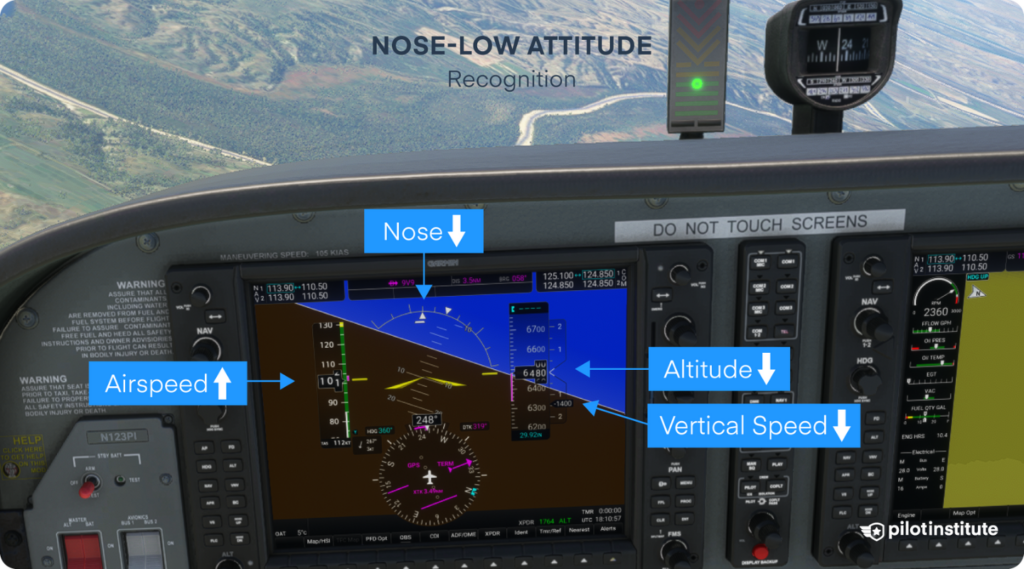
During a nose-low unusual attitude, you will have the following:
- High or increasing airspeed – read from your airspeed indicator.
- Decreasing altitude – read from your altimeter.
- An increasing rate of descent. – read from your vertical speed indicator.
- Increase of engine RPM – read from your engine RPM gauge.
- A low-nose attitude – seen on your attitude indicator.
Recovery
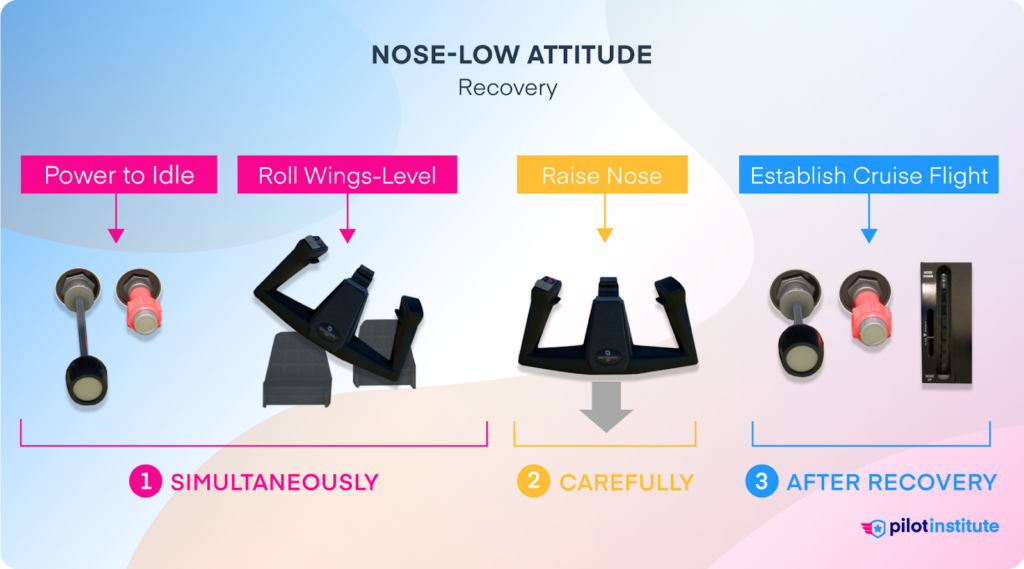
As soon as you realize you are in a nose-low unusual attitude, you should immediately reduce power. Simultaneously level the wings. Ease out of the dive while you are monitoring your airspeed. When you reach a straight and level attitude, maintain it by adding power. Set cruise power and retrim aircraft as required.
Tips
It is crucial to level the wings first before easing out of the dive. Not doing so could overstress the aircraft.
Spiral Dive
Recognition

During a spiral dive, you will have the following:
- High or increasing airspeed – read from your airspeed indicator.
- Decreasing altitude – read from your altimeter.
- High angle of bank – shown on your attitude indicator and turn coordinator.
- High rate of descent – shown on your vertical speed indicator.
- High or increasing ‘G’ loading – felt by yourself.
- Increase of engine RPM – read from your engine RPM gauge.
Recovery
Close the throttle immediately and simultaneously level the wings. Use rudder to check balance. Ease out of the dive while monitoring your airspeed (looking for a decrease). When the altimeter stops decreasing in altitude, hold your attitude. Then, restore cruise power. Trim the aircraft as required.
Tips
Remember to use smooth control movements when maneuvering above Va (maneuvering speed). Abrupt control movements above this speed may cause damage to the airframe.
Common Recovery Mistakes
Recovering from an unusual attitude does sound daunting. You are generally in an uncomfortable position in the sky, which forces you to act fast. So you’re bound to make mistakes.
To make your life easier, we’ve compiled a list of common recovery mistakes. So you can be aware of them when starting out.
Incorrect Attitude Identification
Acting without correct identification can make the situation worse. Use all available information to identify the actions required for recovery. Make sure you spend a couple of seconds scanning the instruments. Get a good picture of what is happening before acting.
Fixation
Fixation on a single instrument can cause the correct initial response. But the incorrect recovery.
The following example relates to a nose-low unusual attitude. If you pull back on the control column, you will see a reduction in the rate of descent. You can see this on your vertical speed indicator, which shows the correct reading. However, this is the incorrect recovery, as you must level the wings first before easing out of the dive.
Focus on keeping up a good scan where you are assessing information from all instruments. This is crucial to get a full picture of the situation.
Improper Trimming
Failing to keep the aircraft trimmed can cause you to reenter an unusual attitude. Make sure your aircraft is always trimmed out. This is so you do not fight the controls if you find yourself in this situation.
Commercial Pilot ACS Standards
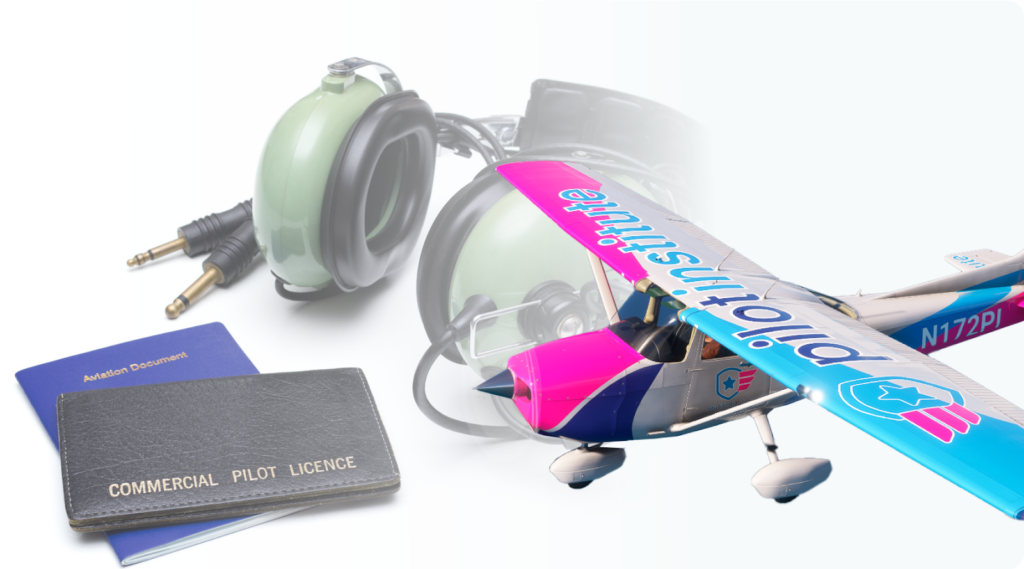
You will have to recover from an unusual attitude during your checkride.
So, it is within your own best interest to know the Airman Certification Standards (ACS).
To meet the ACS standards, you must be able to:
- Recognize when you are in an unusual attitude.
- Perform the correct, coordinated, and smooth flight control application.
- Resolve the unusual pitch and bank attitudes while staying within the aircraft’s limitations.
Conclusion
No one ever wants to end up in a situation where they’ve lost control of their aircraft. But as pilots, we have to train for the worst and hope for the best.
Having a good grasp of this topic, will no doubt save your life if you are unlucky enough to end up in one.
Do you know what other maneuver might save your life?
A go-around. If you’re interested in checking out our latest article about go-arounds. Click here.
